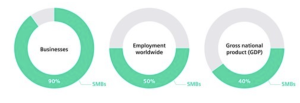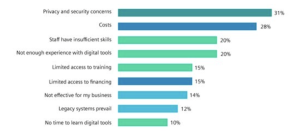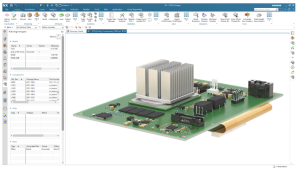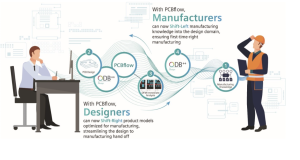Cloud DFM for PCBs: Better Collaboration between Designers and Fabricators

By Susan Kayesar, Siemens Software

As an example, in India, raised consumption of electronics is expected give a boost to the top lines of SMBs in the current fiscal year (FY23). In FY22, SMBs accounted for 25 to 35 percent of the sector, playing a key role in both consumer and industrial electronics. This fiscal year, SMBs are expected to log a revenue growth of 13 to 16 percent year-on-year (YoY), driven by cell phones, consumer and industrial electronics, computer hardware, and strategic electronics. [2]

Figure 1. SMBs play a significant role across industries and particularly in developing countries.
SMBs are under pressure to adopt recent technologies and expand their product portfolios. They are also investing in new technologies, such as IoT, artificial intelligence (AI), 5G cellular and cloud computing to gain a competitive edge. The adoption of these technologies will help SMBs improve their operational efficiency, reduce costs, offer better customer experiences and scale their businesses.
However, SMBs face many challenges. They often lack the financial resources and the economies of scale that larger businesses have. As a result, they may find it difficult to compete against large enterprises. In addition, SMBs may have difficulty accessing the latest technology and tools due to their cost and the resources required to onboard them. They may also struggle to attract and retain qualified employees.

Figure 2. SMBs’ top barriers to adopting digital tools. [3]
Cloud-based Tools
The market for cloud-based tools is growing, with businesses of all sizes adopting these tools to improve their efficiency, agility and productivity. An international survey conducted by O’Reilly in July 2021 found that 90 percent of companies are using cloud computing, up from 88 percent in 2020. [4]
A 2019 report on SMBs in the United States noted that more than 80 percent used digital tools for internal management and logistics to improve business processes and productivity. [3] Examples of these tools are cloud-based software solutions, enterprise resource planning (ERP) software, and proprietary software to connect sales with supply chain operations
There are a few key enablers to the trend:
- Cloud-based tools require no on-premises installation or integration, eliminating a significant burden on information technology (IT) and administration staff.
- Cloud-based tools are becoming increasingly user-friendly, which makes them easier for businesses to adopt.
- The cost of cloud-based tools is dropping, making them more affordable for businesses. Some of the cost decreases are the natural result of technologies maturing. However, a major element in their growing affordability is lower operational costs that come with use of cloud-based tools. A 2020-2021 study found that for companies requiring fewer than 1,000 licenses of Unified Communications as a Service (UCaaS) cloud-based software tools, the annual total spend per license was about 37 percent cheaper than it would be for each on-premises license. This considers the license cost as well as operational costs such as IT staff, equipment maintenance, training and power. [5]
- The security and reliability of cloud-based tools has made significant improvements, making them more attractive to businesses. For example, security measures are incorporated starting at the development stage and updated regularly during the entire lifecycle of software tools, instead of being an afterthought. Customized cloud disaster recovery strategies and secure access service edge (SASE) are now commonly implemented as part of the roll out strategy for cloud-based tools.
Who Is Migrating to the Cloud
In July 2021, half (48 percent) of the companies responding to a survey said they are planning to migrate at least 50 percent of their applications to the cloud within a year, while one-fifth (20 percent) said they plan to migrate all their applications to the cloud [4]. SMBs are migrating more of their workloads and data to the cloud than enterprises. According to a 2022 Flexera report, 63 percent of SMB workloads and 62 percent of data would reside in the cloud by 2023. In comparison, 55 percent of enterprise workloads and 54 percent of data would be in the cloud. [6]
Data security is vital to cloud migration. In the past, some organizations hesitated to put certain types of data in public cloud infrastructure, but that is changing as organizations gain confidence in cloud providers’ data security practices. Over 50 percent of companies report they will consider moving some or all their corporate financial data or sensitive consumer data to the cloud. [6]
Beyond security considerations, as companies progress along their journey to the cloud, their perception of the challenges are changing. A Forrester study noted that in 2020, companies ranked their top two cloud migration challenges as identifying the best workloads to run on the cloud and training staff on cloud services, in that order. By November 2021, the top two spots were, in order, post-migration optimization of apps, and performance issues related to workloads that had been migrated to the cloud. [7]
Despite initial challenges, companies are seeing significant IT and business benefits from moving workflows to the cloud. In the same study, 78 percent of businesses attributed improved or consistent application workload performance to cloud migration. Sixty percent cited easier IT operations and management as one of the most important IT outcomes they had experienced. Asked about the most important business outcomes, 53 percent cited better end-user experience from apps running in the cloud, and 52 percent cited improved ability to focus on innovation rather than on day-to-day infrastructure management. [7]
Design Automation is Already There
As the world increasingly moves toward cloud-based services, more companies are finding that their electronic design needs can be met using cloud-based tools and platforms. While there are still some companies who cling to on-premises electronic design automation (EDA) tools, the trend is moving toward the cloud.
Examples of companies that are making the switch to cloud-based electronic design include:
- Autodesk: In 2015, the company announced that its AutoCAD3D design software would be available as a cloud-based service. Since then, the company has released additional cloud-based design tools.
- Siemens: The company’s NX design software is now available as a cloud-based service, and it offers various cloud-based design tools for several of its other products (Figure 3).
- PTC: The company has also been moving to the cloud with its electronic design offerings. Its Windchill product lifecycle management (PLM) software is now available as a cloud-based service, and it has been investing in other cloud-based design tools.
- Dassault Systèmes: The company’s Solidworks software is now available as a cloud-based service, and it is investing in additional cloud-based design tools.
- Cadence: The company’s Allegro and OrCAD EDA software products are now available as cloud-based services, and it has been investing in other cloud-based design tools as well.

Figure 3: Siemens NX offers PCB design collaboration capabilities.
Smaller companies also now offer cloud-based electronic design. Upverter, EasyEDA, Circuit Make, PCBway and others offer cloud-based design platforms that include component libraries and enable collaboration on design projects. As the cloud continues to mature, we can expect even more companies to make the switch in the years to come.
It is not just software companies that are shifting EDA to the cloud. In May 2022, Advanced Micro Devices announced it would move some of its EDA workloads for chip design onto a public cloud. Its stated reasons for the move were to extend the capabilities of its own data centers and gain advanced networking, storage and artificial intelligence capabilities.
Benefits of Cloud-based Solutions for PCB Manufacturing
Cloud-based solutions can help to improve communication and collaboration between different departments within a company and enable everyone to access the information they need from any location. This can help to improve decision-making and reduce the risk of errors. In addition, cloud-based solutions can help PCB manufacturers save money. By reducing the need for on-site software licenses, servers, data storage hardware and IT staff, companies can reduce their overhead costs. As well, since cloud-based applications are typically subscription-based, companies only pay for what they need, making them more scalable and cost-effective. Finally, cloud-based solutions can help PCB manufacturers to be more agile and responsive to change. With the ability to quickly deploy new applications and services, companies can experiment with new processes and procedures without the need for costly and time-consuming IT projects.
With the rise of cloud-based solutions over the past few years, a new service-centric approach to product development has emerged – known as cloud-based manufacturing or electronic manufacturing services 2.0 (EMS 2.0). This approach is based on a network of suppliers and a shared resource pool accessible through an online platform. During the development process, companies can search for and select the best-fit manufacturing capabilities, specifications and pricing for their projects or products.
Cloud-based manufacturing offers multiple benefits for both PCB designers and manufacturers, including:
- Quick, accurate quoting. Designers can upload their design files to the platform and quickly receive or view quotes and bill of materials (BOM) details from multiple EMS companies.
- Easy access to multiple manufacturers. With online access to a wide range of manufacturing options, designers can efficiently explore varied options across whatever geographies they choose. This also opens the way to finding low-cost manufacturing options.
- Intelligent recommendations. Cloud-based platforms often incorporate an AI-powered recommendations system to assist designers in choosing the right EMS according to their requirements and priorities regarding production capabilities, capacity, quality, pricing and turnaround time.
- Simplified procurement. Cloud manufacturing service providers may share a BOM and quote upfront before acquiring components and getting a PCB manufactured. This way, users can get an estimate of expenses that would be incurred and avoid unexpected costs.
- Easier project management. Cloud-based manufacturing provides full visibility into every aspect of production operations. This makes it simpler to manage projects and enables better resource planning across the end-to-end project.
- Supply chain resilience. With cloud-based collaboration tools to provide decentralized globally accessible product models, manufacturers can move projects around multiple facilities without impacting the timeline or data integrity.
- Scalability. Large manufacturers often struggle to cost-effectively produce small orders, and smaller contract manufacturers often cannot manage large-volume orders. With cloud manufacturing services, it is simple to switch between different manufacturers during the different stages of the product lifecycle. After the initial low-volume orders for early adopters, scaling up to mass volume and back down to low-volume toward the end of the lifecycle becomes seamless.
Next: Moving DFM Into the Cloud
Design for manufacturing (DFM) analysis is the next logical step in taking PCB design and manufacture to the cloud. There are many reasons to do this, but the most compelling are speed, collaboration, scalability and accessibility.
Speed is the most obvious reason to move DFM to the cloud. With on-premises solutions, engineers must wait to requisition, install and configure the necessary software, which is often a time-consuming step. With a cloud solution, they can start immediately. But speed is not just about starting quickly. Cloud-based DFM solutions, such as Siemens PCB Flow, can also help designers iterate faster (Figure 4). With the ability to make changes and see the results in real-time, designers can experiment more and get to the optimal solution faster.

Figure 4: PCB Flow allows designers to work with manufacturers early on.
Collaboration is another key reason to move DFM to the cloud. With on-premises solutions, it can be difficult to get everyone on the same page. With a cloud solution, multiple engineers can work on the same DFM analysis at the same time. This can be a huge time-saver, especially for large projects. Collaboration between geographically disparate design teams is no longer an issue because all are working on the same project simultaneously. Likewise, collaboration between designer and manufacturer no longer needs to be an arduous process. Cloud storage and collaboration can offer secure data transfer between stakeholders as well as direct communication to clarify design intent and reduce time-to-market.
DFM analysis particularly is influenced by the improved collaboration offered by the cloud environment. To date, communication between designer and manufacturer was a time-consuming process, with no standard format to convey true manufacturing capabilities or constraints accurately and efficiently to designers. Previously, manufacturing rules, such as for design rule checking (DRC) and DFM, were conveyed between parties by phone or in complex standards documents and spreadsheets. Now, a single cloud collaboration platform can serve both designer and manufacturer, providing the opportunity for manufacturers to directly communicate both their capabilities and limitations. Designs can be quickly modified to conform, and any uncertainties can be clarified using in-app tools such as chat, notifications, etc.
Scalability and resulting cost savings form the third reason to move DFM to the cloud. On-premises solutions are limited by the number of software licenses purchased, whereas cloud-based solutions are typically subscription-based with no upfront cost. Cloud-based solutions scale up or down as needed, paying for what is used, resulting in cost savings. This is especially relevant for SMBs where the use of DFM software can be sporadic, and purchase of permanent tools might not be justifiable.
Accessibility is the fourth reason to perform DFM on the cloud. Cloud-based solutions can be accessed from anywhere, so engineers can continue to work on DFM analysis even when they are not physically in an office or on-site at the fabrication or assembly plant. In the emerging post-COVID19 hybrid mode of work, this is a big advantage for maintaining efficiency. The online software needs no maintenance or updating, guaranteeing access to the most recent version, latest features and functionality with no additional operator or IT investment. These solutions are accessible to all potential users, regardless of the company’s size or budget. This egalitarian access will further disrupt the balance of enterprises vs. SMBs in the PCB design industry because it makes quality DFM and collaboration with previously unreachable partners.
To find out more about our online DFM solution for PCBs, visit PCBflow.
References
- “The Worldwide Electronic Manufacturing Services Industry is Projected to Grow at a CAGR of 8.64% Between 2020 and 2025,” Globe Newswire, 23 October 2020, https://www.globenewswire.com/news-release/2020/10/23/2113660/0/en/The-Worldwide-Electronic-Manufacturing-Services-Industry-is-Projected-to-Grow-at-a-CAGR-of-8-64-Between-2020-and-2025.html
- “Revenue outlook bright for electronics SMEs: Crisil SME Tracker,” Business Standard, 27 May 2022, https://www.business-standard.com/article/sme/revenue-outlook-bright-for-electronics-smes-crisil-sme-tracker-122052500866_1.html
- Deloitte Financial Advisory, S.L.U., “The performance of Small and Medium Sized Businesses in a Digital World,” Deloitte, 2019.
- M. Loukides, “The Cloud in 2021: Adoption Continues,” O’Reilly Media Inc., 2021.
- R. Gareiss, “Cost of moving to the cloud drops with time and experience,” Tech Target, 17 April 2020, https://www.techtarget.com/searchcio/tip/Cost-of-moving-to-the-cloud-drops-with-time-and-experience
- “Flexera 2022 State of the Cloud Report,” Flexera, 2022.
- “State of Public Cloud Migration, 2022,” Forrester, 2022.
About the author
Susan Kayesar holds a BSc from Tel Aviv University and brings 20-plus years of experience in the PCB design and verification industry. She is an expert at cultivating creative software solutions to meet real-world customer needs and, in the past, has provided support, training, and consultancy services for both simple and complex product implementations. In her spare time, Susan enjoys travel, hiking, and coffee. In her current position at Siemens, Susan is the Technical Product Manager of PCBflow.












